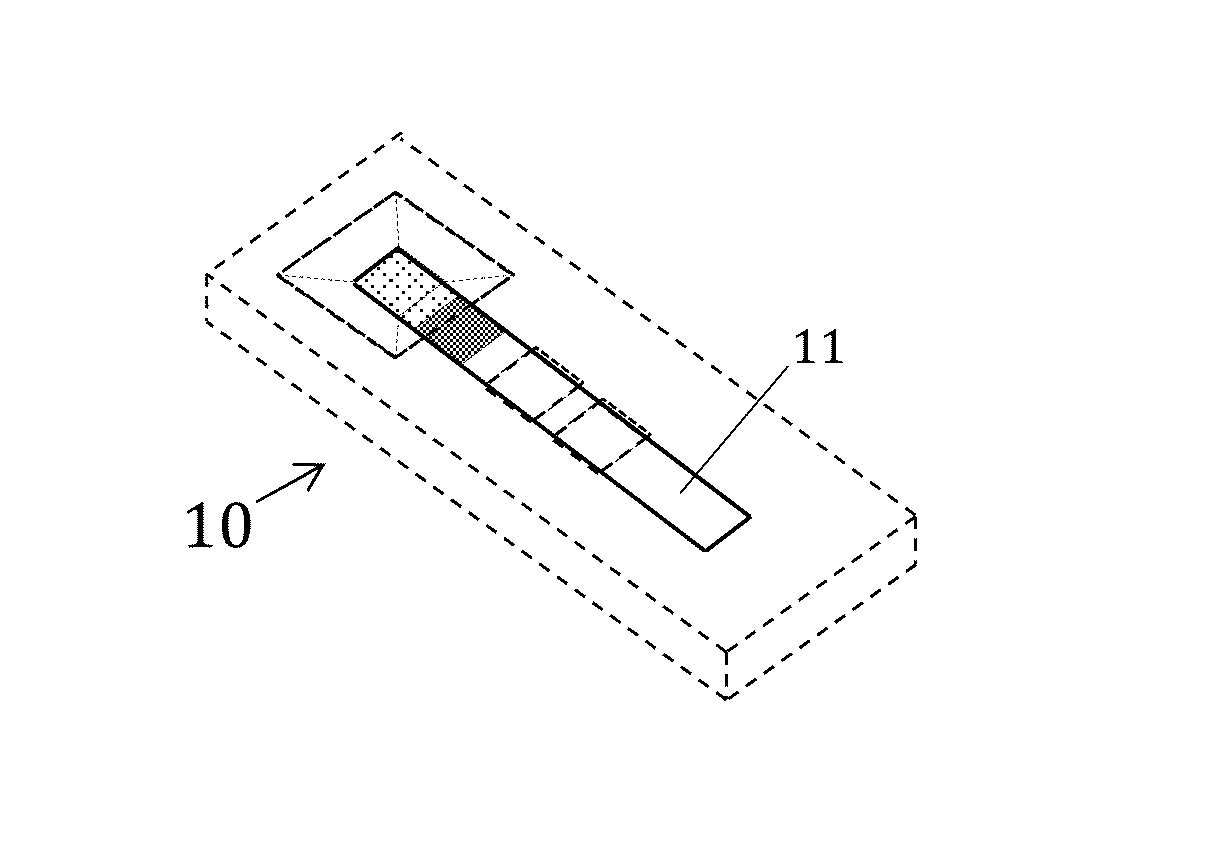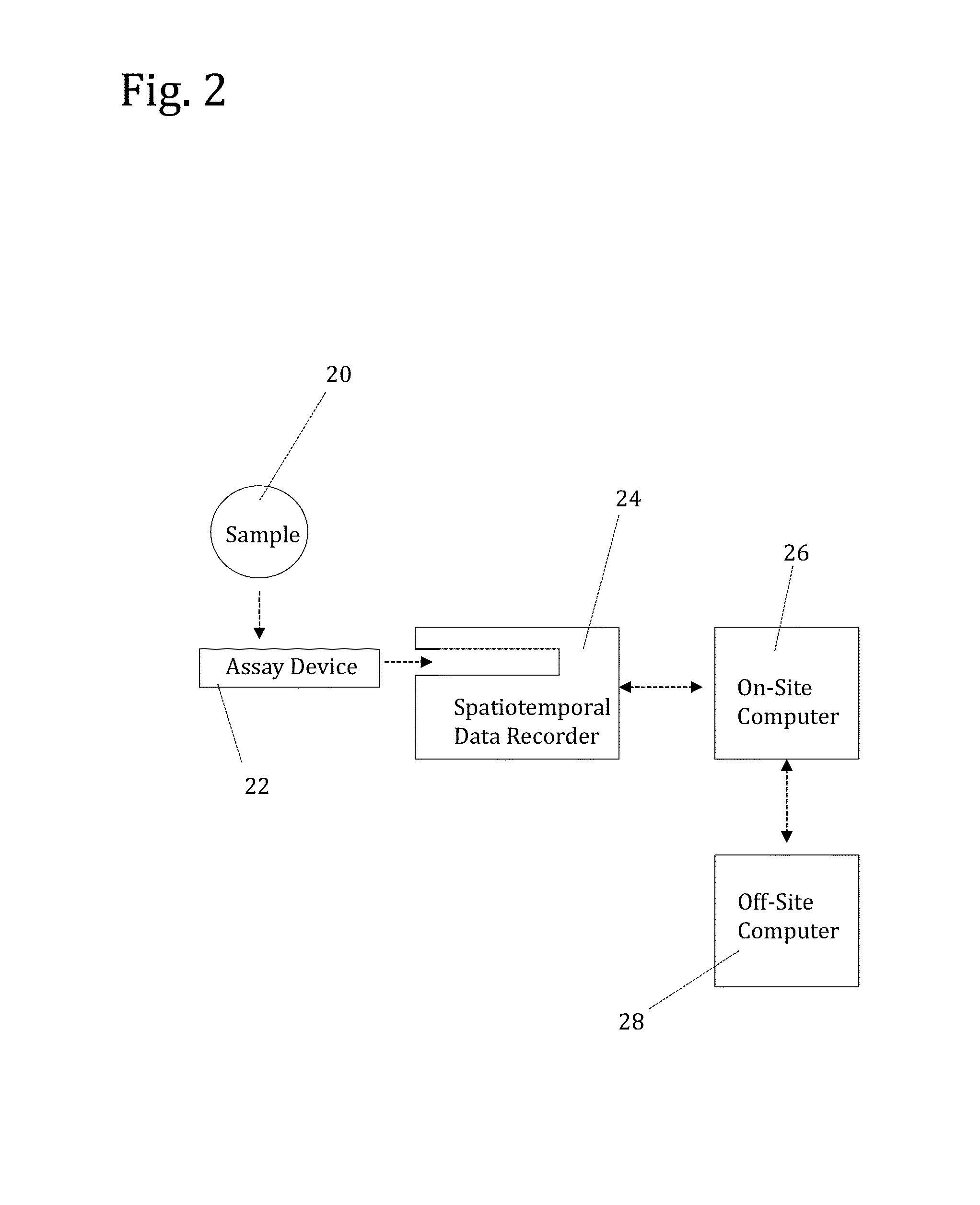System and method for spatiotemporally analyzed rapid assays
a rapid assay and spatiotemporal analysis technology, applied in the field of reliable, rapid, quantitative diagnostic test system, can solve the problems of inability to provide quantitative, significantly less reliable, and intermittent discoloration on the strip
- Summary
- Abstract
- Description
- Claims
- Application Information
AI Technical Summary
Benefits of technology
Problems solved by technology
Method used
Image
Examples
example 1
Preparation of a Vertically Oriented Immunochromatographic Assay Device for the Measurement of Aflatoxin Analyte
[0164]An immunochromatographic assay device was constructed based on the design described in FIG. 8. A housing component was made by cutting a rigid piece of cardboard into a rectangle and attaching an immunochromatographic strip to the housing with double stick tape. The immunochromatographic strip contained reagents for the detection of aflatoxin, and was prepared by standard methods well known in the field. Briefly, a solution of aflatoxin-BSA conjugate was striped onto a plastic backed nitrocellulose sheet to create a capture zone approximately 1 mm wide. Colloidal gold nanoparticles coated with monoclonal anti-aflatoxin antibody were dried onto a strip of glass fiber, which was then partially overlaid onto the nitrocellulose sheet to create a particle region and define a pre-capture zone (between the particle region and the capture zone). A portion of the strip was se...
example 2
Construction of a Spatiotemporal Data Recorder Designed to Accommodate Vertically Oriented Assay Devices
[0165]To analyze the assay devices prepared as described in Example 1, a spatiotemporal data recorder was constructed based on the design shown in FIGS. 12A-12D. FIGS. 13A-13B are a detailed diagrammatic side view of the recorder. As shown in FIG. 13A the recorder is comprised of a movable chamber 132 situated on top of a base 136. The chamber contains an assay device guide 134 for accepting a vertically inserted assay device. A digital camera and light source are contained inside the chamber. FIG. 13B shows the instrument with the chamber lifted so that the camera 138 and LED lights 131 are in view. The camera contains a 0.3 megapixal CMOS image sensor on a circuit board, with a lens over the sensor. The LED lights are attached to the circuit board in this embodiment allowing for both the camera and light source to be operated by (and draw power from) a single source. To homogeni...
example 3
Sequential Digital Images of an Assay Device Test Area Captured on a Spatiotemporal Data Recorder
[0167]Using a vertical test system with components designed as shown in FIG. 8 and FIGS. 12A-12D, the spatiotemporal data recorder (described in Example 2) begins capturing images of the immunochromatographic assay device upon insertion of the device into the recorder, and sequential images are captured at defined time intervals over the course of the flow-induced assay reaction. FIG. 15 shows a set of captured images obtained from a recorder after insertion of an assay device containing a competitive immunoassay strip configured into an assay device as described in Example 1. The test area has the dimensions of approximately 4×18 mm and the recorder incorporates a 0.3 megapixal CMOS image sensor and 2 LED lights, oriented as shown in FIGS. 13A-13B. Images were captured at 5 second intervals, with Image 01 representing the first image captured, Image 02 representing the second image capt...
PUM
 Login to View More
Login to View More Abstract
Description
Claims
Application Information
 Login to View More
Login to View More - R&D
- Intellectual Property
- Life Sciences
- Materials
- Tech Scout
- Unparalleled Data Quality
- Higher Quality Content
- 60% Fewer Hallucinations
Browse by: Latest US Patents, China's latest patents, Technical Efficacy Thesaurus, Application Domain, Technology Topic, Popular Technical Reports.
© 2025 PatSnap. All rights reserved.Legal|Privacy policy|Modern Slavery Act Transparency Statement|Sitemap|About US| Contact US: help@patsnap.com



